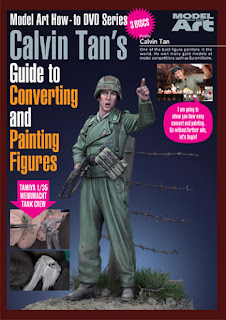Alpine Miniatures - 3rd SBCT, 2nd Inf. Div., Iraq 2007. Sneek previews.........
_
Calvin

In the words of Wilbur Smith "War is the game played by old men with the lives of the young". The pawn in this game is the combat soldier, represented by the miniature toy soldier; an insignificant being on the battlefield. Combat is the most intense moment of war, where life and death balances on a knife's edge. The results are terrifying and reveal the worst part of our human nature. Conversely, there are moments when it exudes the best of our human spirit. Most of the miniatures you see here are diligently researched from historical sources and handcrafted between scales of 1/35 to 1/16 (approx 50mm to 120mm). The intricate rendition of human expression and fine details not only demonstrates the level of craftsmanship but also serves as a reminder of the fragile nature of human life. I represent no political bias though my miniature creations. My aim is to portray humanity through the chronicles of military history and thus it is my pleasure that I present to you my weblog Perspectives in Miniature.


In conjunction with AK Interactive, this exclusive Gen 3 acrylic paint set is specially composed with the essential colours that I use to render WWII German Uniforms. It contains 18 colours and a small pamphlet with my personal colour mixes. If you are keen to acquire all the colours on my palette to paint a field grey tunic, a splinter pattern zeltbahn, an oak-leaf pattern smock or the Kharkov anorak, look no further, this is the set for you to get started.

This instructional DVD published by Model Art magazine was primarily developed for the beginner armour and diorama modeller in mind. The video presentation will feature a variety of easy to master techniques used to render a 1/35 scale plastic injected moulded figure.Topics include proper paint application techniques, choice of brushes as well as some little tricks for painting fine detail. It is fundamentally a showcase of some of my methods and techniques for painting military figures and I am certain it will prove beneficial for any modeller who wishes to improve on figure painting. It is currently available in both Japanese and English.

This video presentation documents the process of rendering a highly detailed 1/35 scale after-market resin figure. Watch as I take the viewer through the process of rendering of leather, uniform insignia as well as camouflage patterns using the techniques and materials presented in the beginner's guide to achieve convincing results. It is available in both Japanese and English.

In this third instalment, I will share my techniques and materials to customize and detail an inexpensive stock plastic figure. Watch as I take you through the steps on how I modify a pose, model details such as hands, belts and webbing and insignias. Learn about working effectively with epoxy putty as well as plastic styrene and paper. As a continuation from my first two DVDs, I will demonstrate how to model and paint a simple groundwork as well as an alternate approach using a monochromatic underpainting to render both a field grey tunic and the World War 2 German Splinter Camouflage pattern on a helmet cover. If you have enjoyed and benefitted from those previous titles, this edition will be a welcome addition to your journey in scale figure modelling – regardless of your current skill level. It is my sincere hope that this could inspire you to embark on your own creative adventure in this fantastic hobby. .
Clubs / Associations

_
_
Thank you all for all the nice comments and keen interest on the painting of the digital camo pattern of the ACU. All of you might have guessed that I was pretty tied up trying to complete the two figures and their spare heads in the past couple of weeks or so to reply to some of your responses. Thus in appreciation for your enthusiastic support and patience, I thought I'll prepare a short pictorial description on my representation of the ACU digital camo.
My first immediate concern was to figure a way to represent this seemingly complex camouflage pattern in 1/35 scale and I found out that the most effective and manageable approach was not to copy the pattern but rather giving a convincing impression of the pattern instead.
What I meant by this is to focus on the general shape of the pattern and not on the little pixels that make up the pattern. And for this to happen one will need to take a step back and observe the pattern from a distance when all the tiny pixels appear as a series of abstract shapes. The digital pattern camouflage is rather arbitrary and one could make up the shapes along the way so long they appear to look "digital". A good idea would be to build up the pattern with Polymino shapes in mind.
Looking at the actual ACU digital camouflage, there are actually two very similar shades of grey that make up the pattern. Considering the effect of scale, I choose to ignore the lighter shade first and used the darker shade to define the general shapes of the grey. This is so that I could get a stronger contrast to define the general shapes. The lighter shade later be introduced along the areas of highlight on the uniform serving both functions of shading and representation.
_
Well finally after a hectic week of balancing of work and family, I was able to get some bench time (courtesy of the national holiday) yesterday to make more progress to the painting of the second installment of Alpine Miniatures's upcoming release. Yup, it might seem sensible attempting to paint this scheme no more than once in one's lifetime but unfortunately for me I'm experiencing twice the masochistic pleasure of this endeavor.
MILITARY ILLUSTRATORS
Where to Makan(Malay for Eat) in Singapore


Calvin Tan Calvin Tan Calvin Tan
